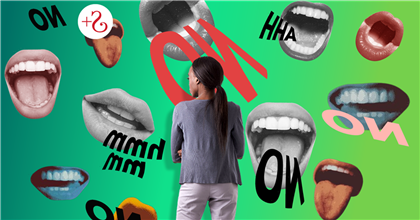Written by Felicity Martin
From requesting a tour of a FedEx driver’s truck to asking to buy an individual piece of fruit at a smoothie bar, rejection therapy encourages participants to get used to being told ‘no’ – but does it really work?
On her first day of rejection therapy, it took Halle an hour to work up the courage to ask a stranger to borrow $100. After the interaction, she was shaking and sweating. But by day 59 of doing small challenges like these, she’s happily walking into a restaurant and asking to keep the plastic buzzer as a souvenir, laughing all the way to her table when she gets the inevitable “sorry, no”.
21-year-old Halle from Virginia Beach is documenting her journey to millions of viewers on TikTok. “For as long as I can remember, I’ve been extremely sensitive to rejection,” she tells Stylist. “Whether it was for school, my career or personal life, I avoided putting myself in vulnerable or uncomfortable situations because the thought of being rejected was unbearable. It was impacting my life.”
She came across rejection therapy, a concept coined by Canadian entrepreneur Jason Comely and further popularised by Jia Jiang in a TED talk from 2016. The idea is to go out and seek potential knock-backs, and Jiang put together a day-by-day programme of 100 ways to put yourself in uncomfortable positions, from asking for a ‘burger refill’ at a fast food chain to making an announcement on a busy plane. Each task is meant to help to desensitise the feeling of rejection, making it easier to ask for what you want when you’re not afraid of getting a big hell no.
Still, Halle was “absolutely terrified” to begin with, she says. “Even the thought of starting this challenge gave me anxiety. But after listening to Jiang’s talk, there was something in my gut telling me I had to do it.”
As the days went on, she started to realise that the outcome was always worse in her head than in reality. She asked to buy individual pieces of fruit from a smoothie bar, requested a truck tour from a FedEx driver and even worked up the courage to try to secure a free hotel room. “Being told no was actually the easiest part of it all – it was everything leading up to it that scared me. I watched my mindset shift from ‘What if they say no?’ to ‘What if they say yes?’” And sometimes it wasn’t a no: she earned herself the “best Christmas card ever” by asking a shopping centre Father Christmas if he could sit on her lap.
But is rejection therapy really that effective or are people just out there wasting strangers’ time? Chartered psychologist Catherine Hallissey sees it as a rework of a strategy regularly used in psychology to overcome anxiety: exposure therapy. “Avoidance is the hallmark of anxiety where short-term avoidance of anxiety-provoking experiences leads to long-term maintenance of anxiety. Exposure therapy involves gradually becoming desensitised to the uncomfortable feeling so you can tolerate it better, leading to less avoidance and reduction of anxiety in the long-term.” She believes its heightened popularity on TikTok and other social platforms is linked to increased difficulties in accessing in-person mental health care, meaning people are taking to the internet to research strategies for themselves.
The practice has sparked intrigue on social media, with plenty of people testing it and documenting their results. “I actually handle rejection pretty well in many areas of my life, especially my career, but I received three rejections last year that I viewed as very important and it made me more fearful,” says 28-year-old Vivienne, founder of Melanin Travel and freelance writer, from London. She’s in the early stages of trying out rejection therapy, but has set herself tasks like asking to take a nap in a mattress shop (they said yes) and requesting to try various drinks before choosing one (“They happily made me all of the samples and gave me a large drink on the house,” she says). “It’s reminded me that getting permission isn’t as hard as you think,” she adds. “I’m very hopeful for many positive outcomes that I know I will achieve by the 100th day.”
Others are sampling the concept of it without sticking to the rigid 100-day structure. Bex Spiller, 33, from Tunbridge Wells, runs wellbeing platform The Anti-Burnout Club and is a self-described ‘anxious introvert’. She’s been doing her own kind of rejection therapy – rather than asking for free burgers, she’s been sending emails out to successful entrepreneurs who have inspired her, asking for a coffee meeting or if they’re able to share some pearls of wisdom. Despite getting zero responses so far, she’s determined to keep trying. “I’ve learned that the worst someone can say is no – or ignore you, but I wouldn’t even get that no without putting myself out there in the first place,” she says. “As a female founder, we’re far more likely to be rejected for things like funding and so I’m hoping my experience will help inspire others to put themselves out there too.”
But rejection therapy can backfire, too, according to clinical psychologist Dr Emma Medard. “You have people who experience an ‘ordinary’ level of fear of rejection – because, honestly, who likes being rejected? – and then there are people who have a more deep-seated, often subconscious, concern that has resulted from difficult early experiences and often links to fears about not being ‘good enough’ or ‘loveable’ or similar,” she explains.
She mentions a patient she saw who fell into the latter category. “[They] experienced overwhelming feelings, ones they had been avoiding for a long time, that they couldn’t cope with, and they became anxious. This just confirmed for them that they were a ‘failure’ and ‘not enough’ as a person and made them feel worse.” Dr Medard adds that what is sometimes missing in the practice is the support and training in emotional regulation skills to handle the experience of rejection differently. “Trained professionals never start any exposure without first erecting the scaffolding. It’s a bit like expecting yourself to learn to swim by jumping in the deep end. You need to be taught the skills first and perhaps a few floats to help you start off.”
For Halle, though, the experience has brought on “genuine connections”, as something of a bonus to getting over her fears. Her task on day 47 was to ask a stranger to pose for a photoshoot, and the man she asked ended up “giving me the best career and life advice” after they talked for hours. “By asking a question I was afraid of, I gained so much insight that night, and turned a stranger into a friend.”
She ended up bringing him a mug printed with the pictures she’d taken of him, to show him how grateful she was. “I told him how much of an impact he’d had on both me and my audience and it was such a heartwarming experience for us both. He gave me advice about rejection and touched so many people’s hearts in the process. James is now someone I look up to as a mentor and is one of the most inspiring and uplifting people I’ve ever met.”
Halle, Vivienne and Bex all believe that others should attempt some form of rejection therapy, as the pay-off counteracts the few painful moments of cringe. Even if you don’t have a major psychological breakthrough, there’s a chance you might make a friend or gain an experience you’d never thought possible thanks to the safe feeling of your comfort zone. As Vivienne puts it: “There are so many opportunities waiting on the other side of fear.”
Images: Getty
Source: Read Full Article

